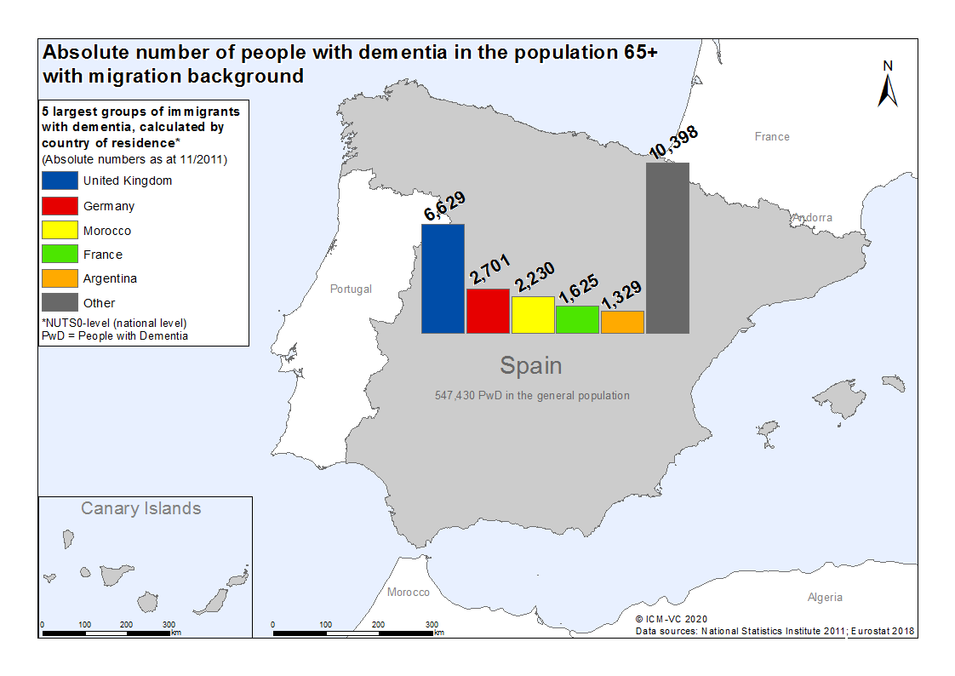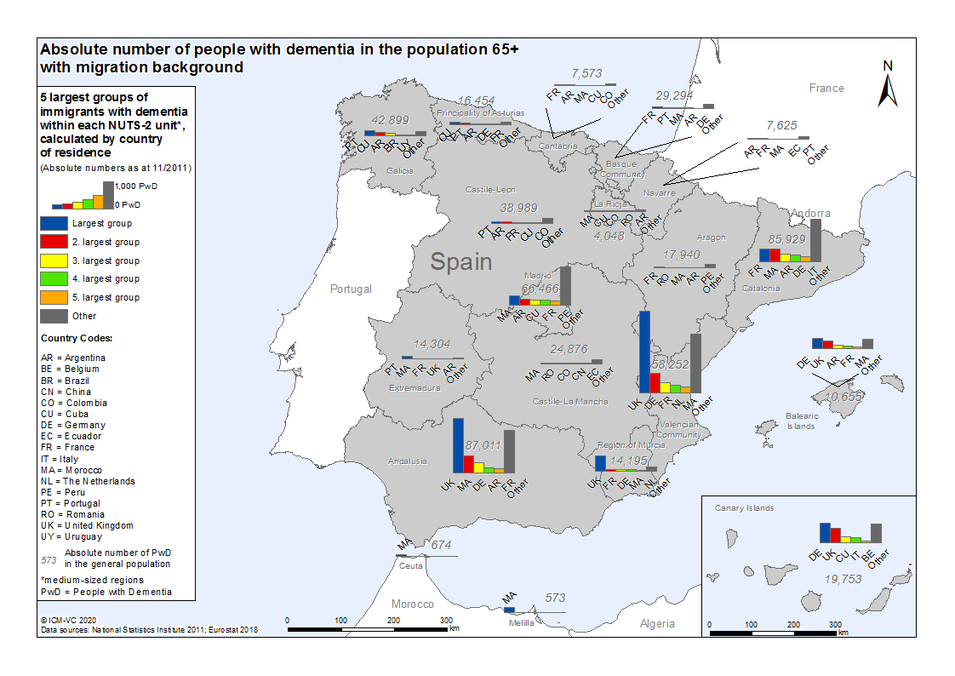EU-Atlas: Dementia & Migration
| Largest group | 2. largest group | 3. largest group | 4. largest group | 5. largest group | |
| Absolute numbers | |||||
| PwMD per 100,000 inhabitants 65+ |
| Absolute numbers | PwMD per 100,000 inhabitants 65+ | |
| Largest group | ||
| 2. largest group | ||
| 3. largest group | ||
| 4. largest group | ||
| 5. largest group |
| Prevalence per 100,000 inhabitants 65+*, calculated by country of residence | |||
|---|---|---|---|
| high > PwMD |
minor > - PwMD |
||
| increased > - PwMD |
low ≤ PwMD | ||
| medium > - PwMD |
|||
| PwMD = People with a Migration background with Dementia *Bulgarien, Litauen, Malta, Polen in der Bevölkerung 60+ |
|||
| Absolute number of PwMD 65+ | |
| PwMD per 100,000 inhabitants 65+ |
Spain
Over the last 500 years, Spain’s migration was characterised by emigration, especially to Latin America. After 1958 emigration shifted towards other European countries1,2. In the 1970s and 1980s, immigration increased. In the following years, migration trends shifted towards south-north migration from North Africa and east-west migration from Central and Eastern Europe1. After the financial crisis in 2008, the number of immigrants decreased for several years. Between 2016 and 2018, the number of refugees and migrants who arrived in Spain via the western Mediterranean route has increased again3. Spain is a popular destination for pensioners from Northern and Western Europe, for foreign workers from Eastern Europe, Portugal, Latin America and North Africa and for migrants from Sub-Saharan Africa1. Between 1990 and 2019, the migrant population (born abroad) more than sevenfold (821,600 to 6.1 million) and the proportion of migrants in the total population more than sixfold (2.1 to 13.1%)4.
There are 361,000 people with a migration background aged 65 or older. Of those, approx. 24,900 are estimated to exhibit some form of dementia. Calculations show the most affected migrant groups presumably originate from Great Britain (approx. 6,600), Germany (approx. 2,700), Morocco (approx. 2,200), France (approx. 1,600) and Argentina (approx. 1,300)5.
The ‘Strategy for Neurodegenerative Diseases of the National Health System’ from 2016 has 165 pages. It addresses different neurodegenerative diseases prevalent in Spain. Aspects such as prevention, or support and care of patients and family caregivers are discussed. However, it does not refer to migration6. The 94-page ‘Comprehensive Plan for Alzheimer's and Other Dementias (2019–2023)’ from 2019, which covers topics such as impact of Alzheimer's disease on society and health, or raising public awareness does not refer directly to migration. However, within the context of several care areas for people with Alzheimer's disease, it highlights the importance of considering the cultural background of the persons with Alzheimer's disease, but there is no specific focus on people with a different cultural background than the autochthonous population7. Overall, the topic of migration does not play a relevant role in these national plans and strategies. The ‘Clinical Practice Guideline on the Comprehensive Care of People with Alzheimer's Disease and Other Dementias’ from 2010 does not have a separate chapter on migration, but in several sections, it refers briefly to the topics of cultural differences in care, the proportion of immigrants among caregivers, and gives some recommendations for improving the care situation8.
References
- Kreienbrink A: Country Profile: Spain. In. Edited by Hamburgisches WeltWirtschaftsInstitut, Bundeszentrale für politische Bildung, vol. 6; 2008.
- Bover O, Pilar V: Migrations in Spain: Historical Backgrouns and Current Trends. In: IZA Discussion Paper. vol. 88; 1999.
- United Nations High Commissioner for Refugees: Spain; 2019.
- International Organisation for Migration: International migrant stock as a percentage of the total population at mid-year 2019: Spain; 2019.
- National Statistics Institute: House and Population Census 2011. In. Madrid: National Statistics Institute 2011.
- Ministerio de Sanidad Servicios Sociales e Igualdad de España: Estrategia en Enfermedades Neurodegenerativas del Sistema National de Salud. In.: Ministerio de Sanidad, Servicios Sociales e Igualdad de España; 2016.
- Ministerio de Sanidad Consumo y Bienestar Social: Plan Integral de Alzheimer y otras Demencias (2019-2023). In. Madrid 2019.
- Ministry of Health Social services and Equality: Clinical Practice Guideline on the Comprehensive Care of People with Alzheimer’s Disease and other Dementias. In. Edited by Ministry of Science and Innovation Spain: Ministry of Science and Innovation Spain; 2010.



![[Translate to Englisch:] Logo RBS [Translate to Englisch:] Logo RBS](/fileadmin/_processed_/9/7/csm_RBS_Logo_RGB_0e245a98a4.jpeg)